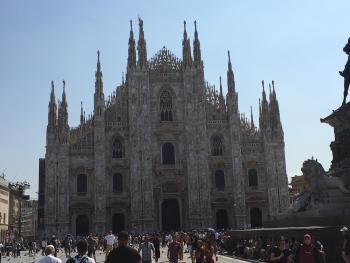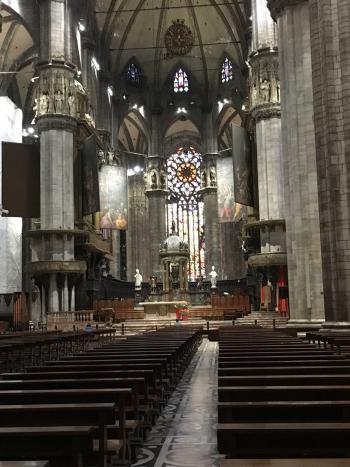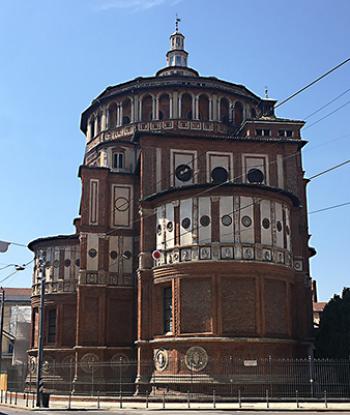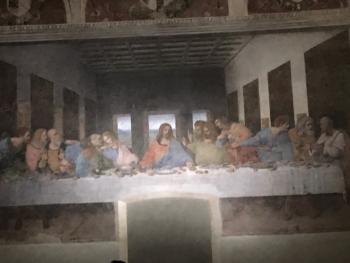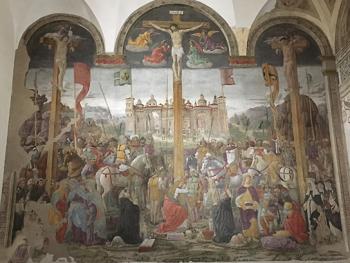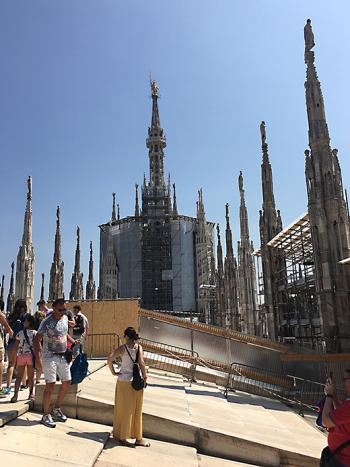HOHO Bus Tours in Milan
This item appears on page 16 of the November 2021 issue.
On a summer trip to Europe in 2018, my husband, Bill, and I flew from Switzerland to Italy, where we stayed at the Holiday Inn Express Milan – Malpensa Airport (888/465-4329, www.ihg.com) for $100 per night, with breakfast. I highly recommend this airport hotel. After several weeks in Europe, it was very nice to have cold air-conditioning, an elevator and an ice machine!
We would stay there again the night before we flew home, but after renting a car and touring other parts of northern Italy (Oct. ’21, pg. 21), we spent another night at the Holiday Inn Express Milan, the next morning taking the shuttle to the airport (€4 each, one way), where we stored our large suitcases for €12 each, then rode the train back into the city (round trip for both of us cost €52).
In Milan, a local train took us close to the very nice, 4-star Hotel Andreola Central (Via Domenico Scarlatti, 24; phone +39 02 6709141, en.andreolahotel.it), where we spent one night for $125, including breakfast.
Our Milan visit was busy, based around a 2-day ticket for Hop-On, Hop-Off Bus Tours (www.hop-on-hop-off-bus.com). Sightseeing independently on Hop-On, Hop-Off (HOHO) buses is our favorite way to see a large city, as we’ve done in cities all over Europe, but this was a special ticket, costing more (€69 each, near $160 for both of us). In addition to the regular bus routes, it included a guided tour to Leonardo da Vinci’s “The Last Supper.”
From Hotel Andreola Central, we walked back to the nearby train station, where there was a HOHO bus stop; I had printed our HOHO Bus Tours vouchers at home. In Milan, the HOHO buses on each route played recorded commentary; in other cities (Dublin and Berlin come to mind), there has been a person doing the commentary.
Our first HOHO stop was the Duomo di Milano — magnificent and one of the largest cathedrals in Europe! The HOHO bus driver was selling tickets (€16 each) for the express elevator to the top of the cathedral, so we bought them and were happy we did not have to wait in the long line for the stairs.
The cathedral was built over centuries, starting in 1386, with the final details added in 1965. The roof was a forest of statues, spires and flying buttresses, with pinnacles crowning it all. At one point, we could peer down into the interior of the cathedral and see the top of one of the massive, 200-foot-tall columns below. It was hot on top of the roof but thrilling, and we had a great view overlooking Milan.
The cathedral can seat 40,000 souls. Beautiful stained-glass windows allow light into the interior. There are thousands of statues inside and outside.
Our second day of touring Milan on the HOHO buses began at La Scala (€7 each), the opera house that was opened in 1778. Along with seeing the stage and seating areas, we read biographies of famous composers and saw extensive costumes, stage props and even Verdi’s tophat. I would love to see a performance there.
We continued to Pinacoteca Ambrosiana (€10 each), the oldest museum in Milan, filled with treasures by Botticelli, Caravaggio, Titian and Raphael. We went there to see a reproduction of “The Last Supper” that was painted only a few years after the original. It is not a full copy, as it only shows the torsos of the figures and the top of the table, but the colors are fantastic!
Admission was free at San Maurizio al Monastero Maggiore. Built around 1500, the church is also called the “Sistine Chapel of Lombardy” because of the beautiful frescoes by Bernardino Luini, a contemporary of da Vinci. The frescoes date to the early 1500s.
The Basilica di Sant’Ambrogio, also free, is one of Milan’s top religious and historic sights. The first church on this site was built around AD 380. The current church dates to the 12th century.
Inside is a central nave with small chapels along each side. At the far end is an elaborate domed altar dating from the mid 800s. The golden mosaics inside the dome are 13th century. We also saw fragments of 12th-century frescoes on columns in the church.
Da Vinci’s Renaissance masterpiece “The Last Supper” is located in the refectory of the Church and Dominican Convent of Santa Maria delle Grazie. Reservations made far in advance are a must. Our guided group tour with Hop-On, Hop-Off Bus Tours, reserved before we left for Europe, was excellent. (I had tried online many times to get tickets to see “The Last Supper,” and I think it was all in Italian. Finally, knowing that HOHO Bus Tours had that visit as an option, I bought the HOHO ticket.)
The building had originally been a Dominican monastery. Leonardo was commissioned in 1495 to paint one end of the monks’ dining hall. However, he did so by painting directly onto the wall in layers as he would on canvas, instead of using the normal fresco method of painting onto wet plaster. Within just a few years, it began to deteriorate.
Several restorations were tried over the centuries, and the last one was completed in 1999 after 21 years of work. That team removed dirt, shellac and paint from previous restorations. What is left is faint, with only bits of the original color, but the painting is still very striking.
The building was heavily damaged by bombing during World War II. Pictures of the aftermath of the bombing are stunning. One has to wonder how the painting survived at all.
Visiting Milan and seeing “The Last Supper” were definitely highlights of our trip to Italy.
LIZ FISCHER
Tarpon Springs, FL

